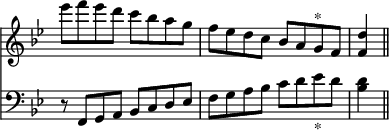of three octaves. Its most effective notes however, and those only which it is safe to employ in choral music, are the notes which can be placed on the stave (unfortunately obsolete) which has the C clef on the second line—from the G below middle C to the octave above the latter—incorrectly called the Mezzo-soprano stave. [Illustration] Though not so penetrating as the soprano, the contralto voice surpasses it in tenderness and in volume; and even, which is more remarkable, in flexibility, recent contralti have certainly equalled, perhaps surpassed, vocalists of every other class. As examples of singers in the full acceptation of the term the names of Grassini, Pisaroni, Brambilla, and Alboni, all contralti, have become historical.
CONTRAPUNTAL is properly that which is written according to the rules of strict Counterpoint, which see; but it is commonly used to describe music of a pure and dignified style, in which the effect is produced more by the independent motion of the parts than by the massing of the harmonies. The larger proportion of early modern music was essentially contrapuntal, and it seems that the first ideas of harmony were derived from the species of counterpoint called Discantus, which was a popular device of the latter part of the eleventh century, and consisted of fitting two independent tunes together. This basis, and the fact that musicians were slow in developing a sense for more than very simple harmonies, made the contrapuntal style their natural mode of musical expression. But the development of the elaborate harmonies of modern instrumental music has so changed its whole character, that an attempt to write true contrapuntal music at the present day is something like trying to write a poem in the English of Chaucer; and very few composers, unless they devote their attention specially to it, are likely to achieve a contrapuntal work which shall not have the appearance of being either forced or meaningless.
CONTRARY MOTION is the progression of parts in opposite directions, one or more ascending while the other or others descend, as—

In contrapuntal music it was considered preferable to similar or oblique motion, and it always has a stronger and more vigorous character than either of these. Many conspicuous examples of its use in modern music may be found, as for instance in the slow movement of Beethoven's Symphony in C minor—

Passing notes are allowed to progress continuously by contrary motion until they arrive at notes which form a part of some definite harmony ( * ), as—

from the first movement of Beethoven's Sonata in B♭, op. 106.
CONTREDANSE (Engl. country-dance, Ger. contretanz). A dance of English origin, which was introduced into France in the Regency, 1715–23, and has since become very popular. The music to the contredanse is of a lively character; it is written either in 2-4 or in 6-8 time, and consists uniformly of eight-bar phrases, each of which is usually repeated. The name probably arose from the fact that the dancers were ranged over against (contre) one another. The English term 'country-dance' is probably a mere adaptation.
Beethoven has written twelve contredanses for orchestra, from one of which he developed the finale of his 'Eroica' symphony. Mozart has also left a large number of specimens of this class of composition. A series of five or six contredanses forms a Quadrille.
CONVERSI, Girolamo, was born at Correggio about the middle of the 16th century, and is known as the author of the following works:—Canzoni a 5 voci; Venice, G. Scotto 1575; reprinted by the same publisher in 1580 in 4to; Madrigali, a 6 voci, lib. 1; Venice 1584; ibid, in 4to. Conversi is familiar to English amateurs through his fine Madrigal 'When all alone my pretty love was playing.'
CONVICT (Convictorium), an establishment existing in many German towns for the free or very economical education of boys; usually connected with the convent system, and supported by the state or private foundation. Its only claim to mention here is the fact that Schubert was educated for the Hof-kapelle at the Convict at 45 in the Piaristen Gasse, Josephstadt, Vienna. That for the choristers of St. Stephen's is in the Stubenbastei, No. 2.
COOKE, Benjamin, Mus. Doc., the son of Benjamin Cooke, a music publisher in New Street, Covent Garden, was born in 1734. In his ninth year he was placed under the instruction of Dr. Pepusch, and made such rapid progress as in three years time to be able to act as deputy for John Robinson, organist of West-
